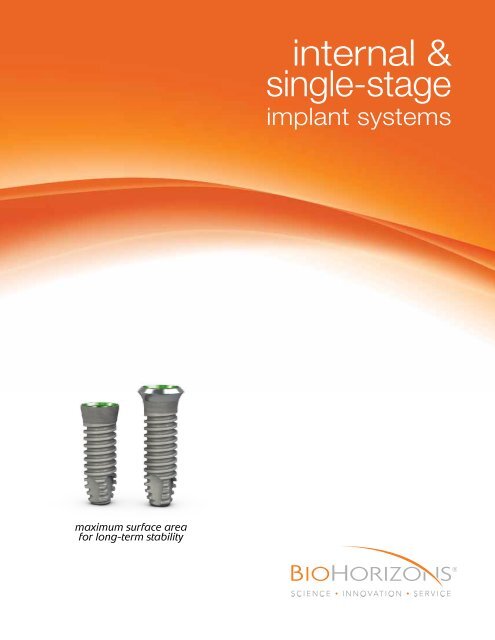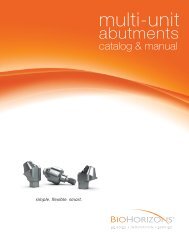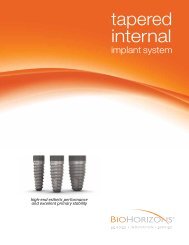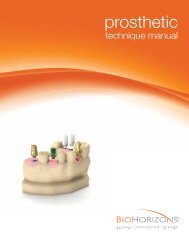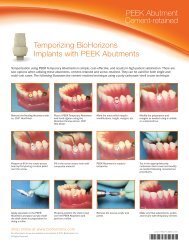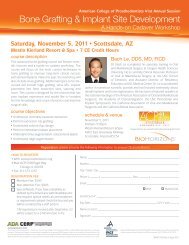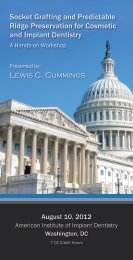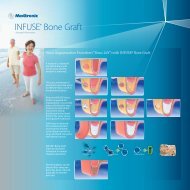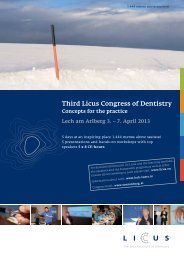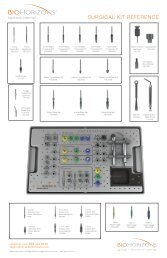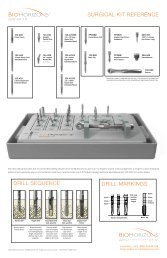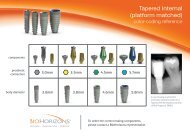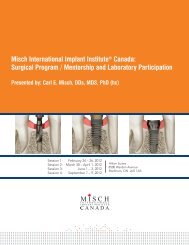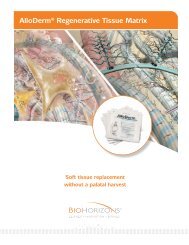Internal & Single-stage - dental implants - BioHorizons
Internal & Single-stage - dental implants - BioHorizons
Internal & Single-stage - dental implants - BioHorizons
Create successful ePaper yourself
Turn your PDF publications into a flip-book with our unique Google optimized e-Paper software.
maximum surface areafor long-term stabilityinternal &single-<strong>stage</strong>implant systems
99.2%average<strong>implants</strong>uccessrate 1<strong>BioHorizons</strong> is dedicated to developing evidence-based and scientifically proven products. From the launch of theExternal implant system (Maestro) in 1997, to the Laser-Lok 3.0 implant in 2010, <strong>dental</strong> professionals as well aspatients have confidence in our comprehensive portfolio of <strong>dental</strong> <strong>implants</strong> and biologics products.Our commitment to science, innovation and service has aided us in becoming one of the fastest growing companiesin the <strong>dental</strong> industry. <strong>BioHorizons</strong> has helped restore smiles in 85 markets throughout Asia, North America, SouthAmerica, Africa, Australia and Europe.globalleader forbiologicbasedsolutionsSCIENCE<strong>BioHorizons</strong> uses science andinnovation to create unique productswith proven surgical and esthetic results.INNOVATIONOur advanced implant technologies,biologic products and computer guidedsurgery software have made <strong>BioHorizons</strong>a leading <strong>dental</strong> implant company.productssoldin 85marketsSERVICE<strong>BioHorizons</strong> understands theimportance of providing excellentservice. Our global network ofprofessional representatives and ourhighly trained customer care supportteam are well-equipped to meet theneeds of patients and clinicians.B
Table of ContentsOverviewPageLaser-Lok Technology Overview<strong>Internal</strong> Implant Overview<strong>Single</strong>-<strong>stage</strong> Implant Overview2-345Section 1: Product CatalogImplantsVIP SoftwareSurgical InstrumentsAncillary InstrumentsW&H Motors & Accessories6-789-1112-1314-15Section 2: Surgical ManualInstructions for UseSurgical ProtocolsImplant Spacing ConsiderationsSurgical Kit Layout & Drill SequenceSurgical Drill OverviewOsteotomy InitializationOsteotomy ModificationFinal Bone Preparation & DriversImplant Pick-upAbutment Level Placement (<strong>Internal</strong> Implant)Implant Level PlacementPost-Operative Instructions<strong>Internal</strong> Implant Healing Protocols<strong>Single</strong>-<strong>stage</strong> Implant Healing ProtocolsIcon Legend & ReferencesOrdering & Warranty Information161718-192021222324-2526272829303132331
Laser-Lok TechnologyLaser-Lok overviewLaser-Lok microchannels is a proprietary <strong>dental</strong>implant surface treatment developed from over 20years of research initiated to create the optimal <strong>implants</strong>urface. Through this research, the unique Laser-Loksurface has been shown to elicit a biologic responsethat includes the inhibition of epithelial downgrowthand the attachment of connective tissue (unlikeSharpey fibers). 2,3 This physical attachment producesa biologic seal around the implant that protectsand maintains crestal bone health. The Laser-Lokphenomenon has been shown in post-market studiesto be more effective than other implant designs inreducing bone loss. 4,5,6,7SEM image at 30X showing the Laser-Lok zoneon a <strong>BioHorizons</strong> implant.The uniformity of the Laser-Lok microstructureand nanostructure is evident using extrememagnification.Unique surface characteristicsLaser-Lok microchannels is a series of cell-sized circumferential channels that are precisely created using laser ablation technology.This technology produces extremely consistent microchannels that are optimally sized to attach and organize both osteoblasts andfibroblasts. 8,9 The Laser-Lok microstructure also includes a repeating nanostructure that maximizes surface area and enables cellpseudopodia and collagen microfibrils to interdigitate with the Laser-Lok surface.soft tissueLaser-LokimplantLaser-LokimplantHuman histology shows the apical extent of thejunctional epithelium below which there is asupracrestal connective tissue attachment to theLaser-Lok surface. 2bonePolarized lights show the connective tissue isfunctionally oriented. 2Colorized SEM of a <strong>dental</strong> implant harvested at6 months post-op shows the connective tissue isphysically attached and interdigitated with theLaser-Lok surface.Different than other surface treatmentsVirtually all <strong>dental</strong> implant surfaces on the market are grit-blasted and/or acid-etched. These manufacturing methods create randomsurfaces that vary from point to point on the implant and alter cell reaction depending on where each cell comes in contact withthe surface. 10 While random surfaces have shown higher osseointegration than machined surfaces, 11 only the Laser-Lok surface hasbeen shown using light microscopy, polarized light microscopy and scanning electron microscopy to also be effective for soft tissueattachment. 2,12shop online at www.biohorizons.com2
The clinical advantageThe Laser-Lok surface has been shown in several studiesto offer a clinical advantage over other implant designs.In a prospective, controlled multi-center study, Laser-Lok <strong>implants</strong>, when placed alongside identical <strong>implants</strong>with a traditional surface, were shown at 37 monthspost-op to reduce bone loss by 70% (or 1.35mm). 4 In aretrospective, private practice study, Laser-Lok <strong>implants</strong>placed in a variety of site conditions and followed up to 3years minimized bone loss to 0.46mm. 5 In a prospective,University-based overdenture study, Laser-Lok <strong>implants</strong>reduced bone loss by 63% versus NobelReplace Select. 6Change in Bone Level (mm)Crestal Bone LossLaser-LokControl0.00-0.500.59mm-1.00Laser-Lok advantage-1.501.94mm-2.00-2.501 5 9 13 17 21 25 29 33 37Months Post-OpIn a 3-year multicenter perspective study, the Laser-Lok surface showed superior bone maintenanceover identical <strong>implants</strong> without the Laser-Lok surface. 4Latest discoveriesThe establishment of a physical, connective tissueattachment (unlike Sharpey fibers) to the Laser-Loksurface has generated an entirely new area of research anddevelopment: Laser-Lok applied to abutments. This couldprovide an opportunity to use Laser-Lok abutments tocreate a biologic seal and Laser-Lok <strong>implants</strong> to establishsuperior osseointegration 9 – a solution that offers the bestof both worlds. Alternatively, Laser-Lok abutments couldsupport peri-implant health around <strong>implants</strong> withoutLaser-Lok. In a recent study, Laser-Lok abutments andstandard abutments were randomly placed on <strong>implants</strong>with a grit-blasted surface to evaluate the differences. Inthis proof-of-principle study, a small band of Laser-Lokmicrochannels was shown to inhibit epithelial downgrowthand establish a connective tissue attachment (unlikeSharpey fibers) similar to Laser-Lok <strong>implants</strong>. 12 This time,however, the attachment was established above the <strong>dental</strong>implant-abutment connection and even on <strong>implants</strong> witha machined collar. 12 The resulting crestal bone levels werehigher than what was seen with standard abutments andprovides some insight into the role soft tissue stability mayplay in maintaining crestal bone health.EpithelialdowngrowthBonelossStandardabutmentat 3 months200µmLaser-Lokabutmentat 3 monthsConnectivetissueNewboneComparative histologies show the biologic differences between standard abutments and Laser-Lokabutments including changes in epithelial downgrowth, connective tissue and crestal bone health. 12Exposedimplant collarStandardabutmentat 3 monthsLaser-Lokabutmentat 3 monthsLaser-LokmicrochannelstissueflapComparative SEM images show the variation in tissue attachment strength on standard and Laser-Lokabutments when a tissue flap is incised vertically and manually lifted using forceps. 12Laser-Lok Technologyis available on Laser-Lok 3.0,Tapered <strong>Internal</strong>, <strong>Single</strong>-<strong>stage</strong>,<strong>Internal</strong> <strong>implants</strong> & abutments3• NobelReplace is a trademark of Nobel Biocare.shop online at www.biohorizons.com
INTERNAL/SINGLE-STAGE OVERVIEWinternal<strong>Internal</strong> <strong>dental</strong> <strong>implants</strong> providemaximum surface area through the use ofa parallel-walled body and square threaddesign. It also is available with Laser-Lok microchannels to create a physical,connective tissue attachment (unlikeSharpey fibers) and long-term crestalbone maintenance. 2FEATURESProprietary biomechanical thread designmaximizes implant surface area. 13Most widely used connection inimplant dentistry.deliveryoptionsconnectionbody-typeplacementsurfacetreatmentimplantlengthsmount-free3inOne abutmentinternal hexparallel-wallbone levelRBT bodyoptional Laser-Lok collar9.0mm10.5mm12.0mm15.0mmSupported by a comprehensive lineof internally hexed prosthetics.prosthetic platform3.5mm4.5mm5.7mmbody diameter3.5mm4.0mm 5.0mm 6.0mmapical diameterminimum ridge widthminimum mesial/distal space2.0mm5.5mm6.5mm2.1mm6.5mm7.5mm2.5mm7.7mm8.7mm3.5mm8.0mm8.7mmshop online at www.biohorizons.com4
INTERNAL/SINGLE-STAGE OVERVIEWdeliveryoptionsconnectionbody-typeplacementsurfacetreatmentimplantlengthsmount-freeinternal hexparallel-walltissue levelRBT bodyoptional Laser-Lok collar7.0mm9.0mm10.5mm12.0mm15.0mmsingle-<strong>stage</strong>Unlike similar “soft-tissue level” implantdesigns, the <strong>Single</strong>-<strong>stage</strong> <strong>dental</strong> implantfeatures the <strong>BioHorizons</strong> power threadwith maximum surface area to supportthe high occlusal forces often seenin the posterior. This gives dentistsconfidence that their placements willremain secure long-term even withlimited ridge height and in softer bone.FEATURESPower thread provides up to 154%greater surface area. 13Two body diameters for each platform.Greater flexibility than other“soft tissue” <strong>implants</strong>.prosthetic platform3.5mm4.5mm5.7mmshoulder diameter4.5mm 5.5mm 6.7mmbody diameter3.5mm4.0mm4.0mm5.0mm5.0mm6.0mmapical diameterminimum ridge widthminimum mesial/distal space2.0mm5.5mm6.5mm2.1mm6.5mm7.5mm2.5mm7.7mm8.7mm3.5mm8.0mm8.7mm5shop online at www.biohorizons.com
SINGLE-STAGE IMPLANTSAll <strong>Single</strong>-<strong>stage</strong> <strong>implants</strong> come packagedwith a 2mm healing abutment.3.5mm Implant Body3.5mm Prosthetic PlatformSurfaceTreatmentConfiguration:3.5mm x 7mm, 3.5mm platform3.5mm x 9mm, 3.5mm platform3.5mm x 10.5mm, 3.5mm platform3.5mm x 12mm, 3.5mm platform3.5mm x 15mm, 3.5mm platformRBT withLaser-LokLSYR3507LSYR3509LSYR35105LSYR3512LSYR3515RBT only configurationsavailable in limitedquantities. Please call foravailability.RBT surfacetreatmentSYR3507SYR3509SYR35105SYR3512Not available4.0mm Implant Body3.5mm Prosthetic Platform4.0mm x 7mm, 3.5mm platform4.0mm x 9mm, 3.5mm platformLSYR4007LSYR4009SYR4007SYR40094.0mm x 10.5mm, 3.5mm platformLSYR40105SYR401054.0mm x 12mm, 3.5mm platformLSYR4012SYR40124.0mm x 15mm, 3.5mm platformLSYR4015Not available4.0mm Implant Body4.5mm Prosthetic Platform4.0mm x 7mm, 4.5mm platform4.0mm x 9mm, 4.5mm platformLSGR4007LSGR4009SGR4007SGR40094.0mm x 10.5mm, 4.5mm platformLSGR40105SGR401054.0mm x 12mm, 4.5mm platformLSGR4012SGR40124.0mm x 15mm, 4.5mm platformLSGR4015Not available5.0mm Implant Body4.5mm Prosthetic Platform5.0mm x 7mm, 4.5mm platform5.0mm x 9mm, 4.5mm platformLSGR5007LSGR5009SGR5007*SGR5009*5.0mm x 10.5mm, 4.5mm platformLSGR50105SGR50105*5.0mm x 12mm, 4.5mm platformLSGR5012SGR5012*5.0mm x 15mm, 4.5mm platformLSGR5015Not available5.0mm Implant Body5.7mm Prosthetic Platform5.0mm x 7mm, 5.7mm platform5.0mm x 9mm, 5.7mm platformLSBR5007LSBR5009SBR5007SBR50095.0mm x 10.5mm, 5.7mm platformLSBR50105SBR501055.0mm x 12mm, 5.7mm platformLSBR5012SBR50125.0mm x 15mm, 5.7mm platformLSBR5015Not available6.0mm Implant Body5.7mm Prosthetic Platform6.0mm x 7mm, 5.7mm platform6.0mm x 9mm, 5.7mm platformLSBR6007LSBR6009SBR6007*SBR6009*6.0mm x 10.5mm, 5.7mm platformLSBR60105SBR60105*6.0mm x 12mm, 5.7mm platformLSBR6012SBR6012*6.0mm x 15mm, 5.7mm platformLSBR6015Not available*call for availabilityshop online at www.biohorizons.com7
2300 Riverchase Center • Birmingham, Alabama • 35244L0302 Rev B AUG 2009VIP is not available in all countriesVIP SOFTWAREVirtual Implant Placement (VIP)VIP was exclusively developed for clinicians who prefer an innovative and user-friendly treatment planning solutionto help deliver a predictable surgical outcome. The integration of digital treatment planning for diagnosis and ourCompu-Guide surgical templates for guided surgery gives you the confidence for a safe and effective procedure.VIP BENEFITS• Interactive 2D and 3D treatment planning• Open implant platform designed for cross implant compatibility• DICOM converter for instant file conversionVIP virtual surgicalplan transfersto Compu-Guidesurgical template forimplant position andorientationMinimal System Requirements• Windows® XP• Pentium® III CPU, 500 MHz, 256 MB RAM• 1 GB of free hard disk space• Windows supported mouse• 15” computer monitor• Windows Internet Explorer® 6If VIP installation CD does not start automatically, right-click on theCD-ROM drive, select Explore and doubleclick on the VIP setup icon.VIP CD installation is only a demo and requires a user license for the fullversion of VIP.© 2009 <strong>BioHorizons</strong>, Inc. All Rights Reserved.VIP 2.1 software, Rev Bw w w . b i o h o r i z o n s . c o m<strong>BioHorizons</strong> USA888.246.8338 or 205.967.7880<strong>BioHorizons</strong> Canada866.468.8338 or 905.944.1700<strong>BioHorizons</strong> Spain+34 91.713.10.84<strong>BioHorizons</strong> UK+44 8700.620.550<strong>BioHorizons</strong> Germany+49 7661.909989.0<strong>BioHorizons</strong> Australia+61 2.8399.1520<strong>BioHorizons</strong> Chile+56 2.361.9519VIP2.1VIP 2.1 SoftwareVirtual Implant Placement 2.1VIPInteractive 2D and 3D treatment planning software.Includes (2) software licenses.L0303VIP Catalog & Surgical Manualshop online at www.biohorizons.com8
SURGICAL INSTRUMENTSIndividual ComponentsPT35PT40PT50PT60<strong>Internal</strong> / <strong>Single</strong>-<strong>stage</strong> 3.5mm Bone Tap<strong>Internal</strong> / <strong>Single</strong>-<strong>stage</strong> 4.0mm Bone Tap<strong>Internal</strong> / <strong>Single</strong>-<strong>stage</strong> 5.0mm Bone Tap<strong>Internal</strong> / <strong>Single</strong>-<strong>stage</strong> 6.0mm Bone TapPCBD35PCBD40PCBD50PCBD60<strong>Internal</strong> 3.5mm Crestal Bone Drill<strong>Internal</strong> 4.0mm Crestal Bone Drill<strong>Internal</strong> 5.0mm Crestal Bone Drill<strong>Internal</strong> 6.0mm Crestal Bone DrillSYGIDRS B I D R3.5/4.5mm Implant-level Driver, Ratchet*5.7mm Implant-level Driver, Ratchet*SYGIDHS B I D H3.5/4.5mm Implant-level Driver, Handpiece*5.7mm Implant-level Driver, Handpiece*144-100Straight Parallel Pins (2 per kit)PHAAbutment-level Driver, Handpiece*144-20020° Angled Parallel Pins (2 per kit)PRAAbutment-level Driver, Ratchet**instrument o-rings wear out over time. If an instrument is no longer held securely by its associated driver, order a replacement o-ring through Customer Care.shop online at www.biohorizons.com10
SURGICAL INSTRUMENTSIndividual Components130-000Ratchet144-300Implant Spacer / Depth Probe300-400Hand Wrench*135-351.050” (1.25mm) Hex Driver300-2064mm Square Drive ExtenderReplaced 300-205 starting in June 2010.Includes PEEK C-ring for durable retention inRatchet. Cannot be used with bone taps.Additional Kit ComponentsSYCD35SYCD40SGCD40SGCD50SBCD50SBCD60<strong>Single</strong>-<strong>stage</strong> 3.5mm Counter-sink Drill, 3.5mm platform<strong>Single</strong>-<strong>stage</strong> 4.0mm Counter-sink Drill, 3.5mm platform<strong>Single</strong>-<strong>stage</strong> 4.0mm Counter-sink Drill, 4.5mm platform<strong>Single</strong>-<strong>stage</strong> 5.0mm Counter-sink Drill, 4.5mm platform<strong>Single</strong>-<strong>stage</strong> 5.0mm Counter-sink Drill, 5.7mm platform<strong>Single</strong>-<strong>stage</strong> 6.0mm Counter-sink Drill, 5.7mm platformSold separately; not included in the 122-800 surgical kit.SYSTASGSTASBSTASimple Solutions 3.5mm Surgical Trial Abutment (2 per kit)Simple Solutions 4.5mm Surgical Trial Abutment (2 per kit)Simple Solutions 5.7mm Surgical Trial Abutment (2 per kit)Sold separately; not included in the 122-800 surgical kit.*instrument o-rings wear out over time. If an instrument is no longer held securely by its associated driver, order a replacement o-ring through Customer Care.11shop online at www.biohorizons.com
ANCILLARY INSTRUMENTSExtended Shank Depth Drills with stops122-403122-42507122-42509122-425105122-42512122-42515122-4252.0mm Starter Drill, Extended Shank2.5 x 7mm Depth Drill, Extended Shank2.5 x 9mm Depth Drill, Extended Shank2.5 x 10.5mm Depth Drill, Extended Shank2.5 x 12mm Depth Drill, Extended Shank2.5 x 15mm Depth Drill, Extended Shank2.5mm Depth Drill, Extended ShankExtended Shank Drills have the same depth marks and cutting geometryas our standard drills, but add 8mm of length to the shank.Extended Shank Drills122-430122-432122-437122-442122-447122-4523.0mm Width Increasing Drill, Extended Shank3.4mm Width Increasing Drill, Extended Shank3.9mm Width Increasing Drill, Extended Shank4.4mm Width Increasing Drill, Extended Shank4.9mm Width Increasing Drill, Extended Shank5.4mm Width Increasing Drill, Extended ShankBursExtended Shank Drills have the same depth marks and cutting geometry as ourstandard drills, but add 8mm of length to the shank.122-110 2.0mm Lindemann Bone CutterSide-cutting drill used to correct eccentric osteotomy preparations.122-106 #6 Round BurHex Drivers135-351135-451134-350134-450.050” (1.25mm) One-piece Hex Driver*.050” (1.25mm) One-piece Hex Driver, Long*.050” (1.25mm) Handpiece Hex Driver.050” (1.25mm) Handpiece Hex Driver, Long8.5mm13.5mm6.5mm11.5mmFor installation and removal of Cover Screws, Healing Abutments and AbutmentScrews. The Hex Drivers, Long (134-450 and 135-451) are 5mm longer than thestandard versions (134-350 and 135-351). *In early 2011, a running change wasmade to improve abutment screw retention and handling.shop online at www.biohorizons.com12
ANCILLARY INSTRUMENTSDrivers150-000Surgical DriverUse to drive <strong>implants</strong> into the osteotomy, particularly in the anterior region.The driver holds the Abutment-level Driver, Ratchet which interfaces withthe 3inOne Abutment. Also interfaces with the .050” (1.25mm) Hex Driversas well as Bone Taps and the Implant-level Drivers, Ratchet.PADHHAbutment-level Driver,Hex-chuck Handpiece*Use with compatible W&HHexagon Chucking SystemHandpieces to prevent deformationof the ISO shank latch connection inhigh-torque applications.ATWITL Precise Adjustable Torque WrenchPlace both <strong>implants</strong> and abutments with 9 distinct torque settings(15, 20, 25, 30, 35, 40, 45, 50 and 60 Ncm). A simple twist of thehandle locks in precision-engineered torque values and guaranteesaccuracy and repeatability.Adjustable Torque WrenchesEL-C12374 Elos Adjustable Torque WrenchLightweight titanium design is easy to use as an adjustable torquewrench or a ratchet. Quickly disassembles for cleaning. No calibrationrequired.Tissue PunchesPYTPPGTPPBTP3.5mm Tissue Punch4.5mm Tissue Punch5.7mm Tissue PunchTissue Punches are used in a latch-type handpiece to remove the soft tissue from the crest ofthe ridge prior to osteotomy preparation in a flapless surgical procedure. Available in 3 platformdiameters.Bone Profiling BursPYBPPGBPPBBP3.5mm Bone Profiling Bur & Guide4.5mm Bone Profiling Bur & Guide5.7mm Bone Profiling Bur & GuideUsed at implant uncovery to contour crestal bone for abutments when the implant issubcrestal. For use in latch-type reduction handpieces. The Profiler’s internal geometrymatches the geometry of the included Profiler Guide. The Guide is screwed into the implantand then aligns the Profiler for precise removal of tissue surrounding the platform. Comes inthree sizes corresponding to the three internal prosthetic platforms.*instrument o-rings wear out over time. If an instrument is no longer held securely by its associated driver, order a replacement o-ring through Customer Care.13shop online at www.biohorizons.com
W&H MOTORS AND ACCESSORIES<strong>BioHorizons</strong> proudly distributes W&H implant motors, handpieces and accessories.Additional W&H products and re-order items are available. For more information, contactyour <strong>BioHorizons</strong> representative or visit the online catalog (www.biohorizons.com).W&H Motor KitsMotor Kits include: console, motor with 1.8m attached cable, standard (ImplantMED) or premium (ElcoMED) foot pedal, (3) completedisposable irrigation tubes, USB documentation (ElcoMED), handpiece, bur testing gauge, spray cap and service oil (ships separately).WH-310LElcoMED SA-310 Professional Kit with LEDIncludes LED handpiece (WH-10207530).WH-310ElcoMED SA-310 Professional KitIncludes handpiece (WH-10207510).WH-915LImplantMED 915 Starter Kit with LEDIncludes mono block LED handpiece (WH-10207560).WH-915ImplantMED SI-915 Starter KitIncludes mono block handpiece (WH-10207550).W&H MotorsWH-00900103WH-15933100ImplantMED SI-915 (S-NU Foot Pedal) 1.8m Cable, Blue ConsoleElcoMED SA-310 (with Documentation) 1.8m CableW&H ElcoMED SA-310 and ImplantMED SI-915 Re-Order itemsWH-04363600WH-06338400WH-04757100WH-10940011WH-02038200WH-04035100WH-04013900WH-06338500WH-04035200WH-04014000WH-00929300WH-04032600WH-04019000Disposable Irrigation Tubing, 2.2m (Implantmed and ElcoMED SA-310) (box of 6)Irrigation Spike w/ Roller ClampIrrigation Spray Clip for External and <strong>Internal</strong> Irrigation (set of 3)MD-400 Service-Oil F1Oil Spray Cap for MD-400 Service-Oil F1Pump Tube Complete (ElcoMED SA-200(C)Pump Tube Complete (ImplantMED and ElcoMED SA-310)Spare Irrigation Tube for SpikeSpare Pump Tubes (ElcoMED SA-200(C) (set of 3)Spare Pump Tubes (ImplantMED and ElcoMED SA-310) (set of 3)Spray Tubes (box of 10)Sterilization Motor ProtectorTube Clamps (ImplantMED) (set of 5)shop online at www.biohorizons.com14
W&H MOTORS AND ACCESSORIESSurgical HandpiecesWH-10207530WS-75 E/KM LED G Surgical 20:1 Contra-AngleLED, 20:1, hexagon chucking system, press-button chuck system, forsurgical burs and cutters with a 2.35mm contra-angle shank, internaland external cooling system. Dismantle for easy cleaning.WH-10207510WS-75 E/KM Surgical 20:1 Contra-Angle20:1, hexagon chucking system, press-button chuck system, forsurgical burs and cutters with a 2.35mm contra-angle shank, internaland external cooling system. Dismantle for easy cleaning.WH-10207560WI-75 E/KM LED G Surgical 20:1 Contra-Angle, Mono BlockLED, 20:1, hexagon chucking system, press-button chuck system, for surgicalburs and cutters with a 2.35mm contra-angle shank, internal and externalcooling system.WH-10207550WI-75 E/KM Surgical 20:1 Contra-Angle, Mono Block20:1, hexagon chucking system, press-button chuck system, forsurgical burs and cutters with a 2.35mm contra-angle shank, internaland external cooling system.WH-10209201WS-92 E/3 Surgical 1:2.7 Contra-Angle1:2.7, press-button chuck system with triple spray, for surgical burs andcutters with a 1.6mm friction grip shank. Dismantle for easy cleaning.WH-10101200WH-00001100S-12 Surgical 1:2 Angled1:2, angled, extra slim tip for increased vision, lever chuck system, forsurgical burs and cutters 2.35mm >70mm extra long shaft. Dismantlefor easy cleaning.S-11 Surgical 1:1 Straight1:1, straight, lever chuck system, for surgical burs and cutters2.35mm >45mm shaft. Dismantle for easy cleaning.Prosthodontic ScrewdriverWH-16934000IA-400 Prosthodontic ScrewdriverCordless handpiece with precise torque control from8-40 Ncm, 80:1 contra-angle handpiece with hexagonchucking system, charging station, rechargeable Li-ionbattery, and power cable.Bur Testing GaugeWH-02139800Bur Testing GaugeUse to verify the condition of latch-type burs. Burs in proper conditionwill fit into larger diameter hole, but will not fit into the smaller hole(marked red). Burs that fail either of these tests are unfit for use, andmay cause damage to the handpiece.15shop online at www.biohorizons.com
INSTRUCTIONS FOR USEThis Surgical Manual serves as a reference for <strong>BioHorizons</strong> <strong>Internal</strong> and <strong>Single</strong>-<strong>stage</strong> <strong>implants</strong> and surgical instruments. Itis intended solely to provide instructions on the use of <strong>BioHorizons</strong> products. It is not intended to describe the methodsor procedures for diagnosis, treatment planning, or placement of <strong>implants</strong>, nor does it replace clinical training or aclinician’s best judgment regarding the needs of each patient. <strong>BioHorizons</strong> strongly recommends appropriate training asa prerequisite for the placement of <strong>implants</strong> and associated treatment.The procedures illustrated and described within this manual reflect idealized patient presentations with adequate boneand soft tissue to accommodate implant placement. No attempt has been made to cover the wide range of actual patientconditions that may adversely affect surgical and prosthetic outcomes. Clinician judgment as related to any specificcase must always supersede any recommendations made in this or any <strong>BioHorizons</strong> literature.Before beginning a surgical procedure with <strong>BioHorizons</strong> <strong>implants</strong>:• Read and understand the Instructions for Use accompanying the products.• Clean and sterilize the surgical tray and instruments per Instructions for Use.• Become thoroughly familiar with all instruments and their uses.• Study Surgical Kit layout and iconography.• Design a surgical treatment plan to satisfy the prosthetic requirements of the case.Small diameter <strong>implants</strong> with angled abutments are intended for the anterior region of the mouthand are not intended for the posterior region of the mouth due to possible failure of the implant.Indications<strong>BioHorizons</strong> <strong>Internal</strong> & <strong>Single</strong>-<strong>stage</strong> <strong>implants</strong> are intended for use in the mandible or maxilla for use asartificial root structures for single tooth replacement or for fixed bridgework and <strong>dental</strong> retention.<strong>BioHorizons</strong> <strong>Internal</strong> & <strong>Single</strong>-<strong>stage</strong> <strong>implants</strong> may be restored immediately1) with a temporary prosthesis that is not in functional occlusion or2) when splinted together for multiple tooth replacement or when stabilizedwith an overdenture supported by multiple <strong>implants</strong>.VIP Treatment PlanningVirtual Implant Placement (VIP) treatment planning software is a user-friendly solution thatreduces clinical challenges and enhances post-operative outcomes.• Interactive 2D and 3D treatment planning• Self processing DICOM converter• Case viewer available for download from <strong>BioHorizons</strong> website16
SURGICAL PROTOCOLSTwo-<strong>stage</strong> ProtocolIn a two-<strong>stage</strong> surgery, the implant is placed below the softtissue and protected from occlusal function and other forcesduring osseointegration. A low-profile Cover Cap is placed onthe implant to protect it from the ingress of soft tissue.Following osseointegration, a second procedure exposesthe implant and a transmucosal Healing Abutment is placedto allow for soft tissue healing and development of a sulcus.Prosthetic restoration begins after soft tissue healing.Implant with Cover Cap in atwo-<strong>stage</strong> protocol.<strong>Single</strong>-<strong>stage</strong> Protocol<strong>Single</strong>-<strong>stage</strong> surgery may be accomplished by placinga healing abutment at the time of implant surgery. Thiseliminates the need for a second procedure. Although theimplant is not in occlusal function, some forces can betransmitted to it through the exposed transmucosal element.<strong>Internal</strong> Implant with removableHealing Abutment in a single<strong>stage</strong>protocol.<strong>Single</strong>-<strong>stage</strong> Implantwith removable HealingAbutment in a single-<strong>stage</strong>protocol.Prosthetic restoration begins following osseointegration ofthe implant and soft tissue healing.Non-functional Immediate Restoration<strong>Internal</strong> implant restored with a non-functionalprovisional prosthesis.<strong>Single</strong>-<strong>stage</strong> surgery with non-functional immediateprovisionalization provides the patient a non-functioningprovisional prosthesis early in the treatment plan. Anabutment is placed on the implant at or shortly after surgery,and a provisional restoration is secured using temporarycement. The provisional can help shape the soft tissue profileduring healing.Immediate Function Restoration<strong>Single</strong>-<strong>stage</strong> surgery with immediate function is possiblein good quality bone where multiple <strong>implants</strong> exhibitingexcellent initial stability can be splinted together. Splinting<strong>implants</strong> together can offer a significant biomechanicaladvantage over individual, unsplinted prostheses.<strong>Single</strong>-<strong>stage</strong> <strong>implants</strong> with a splinted prosthesis inimmediate function.17
IMPLANT SPACING CONSIDERATIONSImplant Spacer / Depth ProbePurpose: Multi-function instrument for intraoral measurements.• Five centimeter graduated ruler on shaft~4.25mm16mm14mm12mm10mm15mm13mm11mm9mm7mmThe rectangular end ofthe tool provides intraoralmeasurements.Useful for marking centerto-centerimplant spacingon the ridge.The rectangular end against anexisting crown places the osteotomy~4.25mm from the contact.Probe tip measures osteotomy depth.Note: these markings are differentthan the tapered drill markings<strong>Internal</strong> Implant SpacingDuring implant placement, clinicians must apply their best judgment as to the appropriatespacing for individual patient conditions.The osteotomy centerpoint required to maintain a1.5mm implant-to-tooth spacing is derived using thefollowing calculation:½ [prosthetic platform diameter] + 1.5mmThe measurements for the 3 <strong>Internal</strong> prostheticplatforms are shown below.The osteotomy center-to-center measurementrequired to maintain a 3.0mm edge-to-edge spacingbetween <strong>Internal</strong> <strong>implants</strong> is derived using thefollowing calculation:½ [sum of 2 prosthetic platforms] + 3.0mm.The table below lists the permutations.1.5mm1.5mm3.0mm3.8mmOsteotomy center 3.8mmfrom adjacent tooth(4.5mm implant pictured)8.1mmMeasurement is dependenton the two prostheticplatform diameters.bodydiameter3.5mmosteotomy centerfrom adjacent tooth3.3mmbodydiameter3.5mm3.5mm6.5mm4.5mm5.7mm4.5mm3.8mm4.5mm7.0mm7.5mm5.7mm4.4mm5.7mm7.6mm8.1mmImplant center to center8.7mm18
IMPLANT SPACING CONSIDERATIONS<strong>Single</strong>-<strong>stage</strong> Implant PlacementDuring implant placement, clinicians must apply their best judgment as to the appropriate spacingfor individual patient conditions.The osteotomy centerpoint required to maintain a 2.0mmimplant-to-tooth spacing for <strong>Single</strong>-<strong>stage</strong> <strong>implants</strong> isderived using the following calculation:½ [implant body diameter] + 2.0mm.The figures below illustrate the measurements for the4 implant body diameters.The osteotomy center-to-center measurement requiredto maintain a 3.0mm edge-to-edge spacing for <strong>Single</strong><strong>stage</strong><strong>implants</strong> is derived using the following calculation:½ [sum of 2 implant body diameters] + 3.0mm.The table below lists the different permutations.7.5mm4.0mm3.0mm2.0mmOsteotomy center 4.0mm fromadjacent tooth(4.0mm implant pictured)Measurement is dependent on the two implant body diameters.(3.5, 4.5 & 5.7mm <strong>implants</strong> pictured)bodydiameterosteotomy centerfrom adjacent toothbodydiameter3.5mm4.0mm5.0mm6.0mm3.5mm3.8mm3.5mm6.5mm4.0mm4.0mm4.0mm6.8mm7.0mm5.0mm4.5mm5.0mm7.3mm7.5mm8.0mm6.0mm5.0mm6.0mm7.8mm8.0mm8.5mm9.0mmImplant center to centerPlacement in Uneven RidgesWhen placing the <strong>Internal</strong> implant in an unevenridge, prepare the osteotomy and place the <strong>implants</strong>o that the bone/soft-tissue junction is within theLaser-Lok transition zone. If the discrepancy ismore than the Laser-Lok transition zone, levelingthe ridge can be considered.19
SURGICAL KIT LAYOUT & DRILL SEQUENCESurgical Kit LayoutThe <strong>Internal</strong> / <strong>Single</strong>-<strong>stage</strong> Surgical Kit uses an intuitive layout to guide the surgeon through the instrument sequence. Thesequence begins in the upper left hand corner and works left-to-right and then down. Color-coded lines, instruments andgrommets are matched with each implant and further aid in instrument selection and identification.Prior to use, clean and sterilize the surgical tray and instruments per appropriate Instructions for Use and study the Surgical Kitlayout, color-coding and iconography. Surgical assistants should also be thoroughly familiar with all instruments and their uses.Drill SequenceDepth DrillSequenceWidth IncreasingDrill SequenceDepthGaugesBoneTapsCrestal Bone &Countersink DrillsImplant-level and/orAbutment-level Drivers20
SURGICAL DRILL OVERVIEWDrill MarkingsAll surgical drills included with this system are externally irrigated and designed to be used at drill speeds of 850-2500rpm 14 with steady sterile irrigation. Reduced drill speed may be indicated in softer bone or as drill diameter increases.14mm12mm10mm15mm13mm11mm9mm7mmNote: The depth marks are consistent throughout theStarter Drills, Depth Drills and Width Increasing DrillsThe depth marks are consistent throughout the Starter Drill, Depth Drills, Width Increasing Drills and Bone Taps. The thickbands are each one millimeter wide. Thin lines are used to mark 7mm and 11mm.Important Considerations• Peri-operative oral rinses with a 0.12% Chlorhexidine Digluconate solution have been shown to significantly lower theincidence of post-implantation infectious complications. 15 A pre-operative 30-second rinse is recommended, followedby twice daily rinses for two weeks following surgery.• Drilling must be done under a constant stream of sterile irrigation. A pumping motion should be employed to preventover-heating the bone. Surgical drills and taps should be replaced when they are worn, dull, corroded or in any waycompromised. <strong>BioHorizons</strong> recommends replacing drills after 12 to 20 osteotomies. 16 A Drill-usage Tracking Chart isavailable at biohorizons.com to record this important information.• There is a risk of injury to the mandibular nerve associated with surgical drilling in posterior mandibular regions. Tominimize the risk of nerve injury, it is imperative that the clinician understands the drill depth markings as they relate tothe implant length to produce the desired vertical placement of the implant.21
OSTEOTOMY INITIALIZATION2.0mm Starter Drill2.5mm Depth DrillPurpose: Initiate osteotomy.Purpose: Set osteotomy depth.• Chisel-tip design eliminates “skating” onosseous crest• Prepares site for Paralleling Pins• Matte finish for increased visibility underoperatory lights• Efficient cutting drill design collects bone forautografting• Matte finish for increased visibility underoperatory lightsThe 2.0mm and 2.5mm depth drillsare designed to increase and/or setthe depth of the osteotomy.2.5mm Depth Drills with StopsPurpose: Set osteotomy depth when access or visibility is poor.• Fixed circular ring acts as a definitive drill stop• One drill length for each implant length• 1mm laser-etched line guides supracrestal implant placement22
OSTEOTOMY MODIFICATIONParalleling PinsPurpose: Evaluate osteotomy position and angle.• Provided straight or with a 20° angle• Use after 2.0mm Starter Drill and 2.5mm Depth Drill• 9mm shank for radiographic evaluation of proximity to adjacent anatomy• Hub diameter is 4.0mmWidth Increasing DrillsPurpose: Incrementally widens the osteotomy without creating excessive heat.• Non-end cutting geometry for added safety• Efficient cutting drill design collects bone for autografting• Designed to not cut beyond depth set by Depth DrillsExtended shank versions are available which add 8mm of overalllength. Depth markings are identical to standard length drills.Simple Solutions Trial AbutmentsPurpose: Evaluation of osteotomy position for Simple Solutions restoration.• Represents either:• <strong>Internal</strong> implant with 5.5mm high/1.8mm collar Abutment or• <strong>Single</strong>-<strong>stage</strong> implant with 5.5mm high Abutment• Used following 2.0mm Starter Drill• Shank is 5.0mm long and 2.0mm in diameterTrial Abutments are used to assess final abutment position, margin height and chimney height.They approximate the intra-oral position of either a 5.5mm high / 1.8mm collar <strong>Internal</strong> SimpleSolutions Abutment on an <strong>Internal</strong> implant or 5.5mm high <strong>Single</strong>-<strong>stage</strong> Simple SolutionsAbutment on a <strong>Single</strong>-<strong>stage</strong> implant. A minimum of 1.5mm clearance on the occlusal aspect ofthe Simple Solutions Abutments is recommended to allow adequate thickness for the frameworkand veneer of the laboratory fabricated restoration.23
Crestal Bone Drills (for <strong>Internal</strong> <strong>implants</strong>)FINAL BONE PREPARATION & DRIVERSPurpose: Remove cortical bone at ridge crest for pressure-free seating of the implant collar.• Use when dense cortical bone is present at crest• Rounded non-end cutting hub centers drill in osteotomy• Use following the final Width Increasing Drill for each implantFully seat drillImplant level withosseous crestCountersink Drills (for <strong>Single</strong>-<strong>stage</strong> <strong>implants</strong>)Purpose: Remove cortical bone at ridge crest to countersink <strong>Single</strong>-<strong>stage</strong> <strong>implants</strong>.• Use when dense cortical bone is present at crest• Rounded non-end cutting hub centers drill in osteotomy• Use following the final Width Increasing Drill for each implantFully seat drillImplant platform attissue levelCounter-sink Drills are available (sold separately) for each of the six Implant Body/Prosthetic Platform combinations available in the <strong>Single</strong>-<strong>stage</strong> system. They mustONLY be used if the flared transmucosal collar is to be placed below the osseouscrest. To fully countersink the <strong>Single</strong>-<strong>stage</strong> <strong>implants</strong>, the osteotomies need to beoverdrilled by 1.8mm.ImplantBodyProstheticPlatform5.0mm4.5mmEach of the <strong>Single</strong>-<strong>stage</strong> Counter-sink Drills has a unique double color-code bandrepresenting the Implant Body/Prosthetic Platform combination. Be certain theCounter-sink Drill matches the Implant Body/Prosthetic Platform combinationbeing placed.24
FINAL BONE PREPARATION & DRIVERSBone TapsPurpose: Prepare dense cortical bone for implant threads.• Site specific• 30 rpm or less 17• Final instrument prior to implant placement• Can be driven with a handpiece, Ratchet or Hand WrenchPlace into the osteotomy, apply firm apical pressure and rotate slowly ina clockwise direction. When the threads engage, allow the tap to feedwithout excessive pressure. To remove, rotate the Bone Tap in a counterclockwisedirection, allowing it to back out of the osteotomy. Do not pullon the Bone Tap to remove it from the site.Abutment-Level Drivers (for <strong>Internal</strong> <strong>implants</strong>)Purpose: Engage the pre-mounted 3inOne Abutment on the <strong>Internal</strong> implant todrive into the osteotomy.• Drivers interface with the internal square of the 3inOne Abutment• PEEK plastic snap ring secures 3inOne Abutment• 30 rpm or less 17Implant-level DriversPurpose: Engage the implant’s internal hex to drive mount-free <strong>implants</strong>into the osteotomy.• May also be used following removal of the 3inOne Abutment• Offers a narrower path of insertion than placing with a mount• 30 rpm or less 1725
IMPLANT PICK-UP3inOne Mount TransferMount-free TransferCover CapSurgical mountImplantImplantCover CapCover CapThe Cover Cap for a two-<strong>stage</strong> surgicalprotocol is mounted on a plastic base andpackaged in the vial underneath the implant.The Cover Cap for the <strong>Internal</strong> mount-freeis mounted in the vial cap.DriversquarePEEKsnap ringDriverhexPEEKsnap ringExcess pressure candeform the internalimplant basket andshould be avoided.Engage the 3inOne Abutment with the PEEK snap ring of theAbutment-level driver. The driver square has no retentivefeature and does not need to be engaged. The driver squarewill automatically engage in the osteotomy when the driver isslowly rotated under apical pressure.Engage the implant with the PEEK snap ring of the ImplantlevelDriver. The hex of the driver has no retentive feature anddoes not need to be engaged. The driver hex will automaticallyengage in the osteotomy when the driver is slowly rotatedunder apical pressure.26
ABUTMENT LEVEL PLACEMENT (INTERNAL IMPLANT)Implant PlacementPlace the apex of the implant into the osteotomy, apply firm apical pressureand begin rotating slowly (30 rpm or less is recommended) 17 . When thethreads engage, allow the implant to feed without excessive pressure. Ifthe handpiece is unable to fully seat the implant, remove the 3inOne andcomplete placement using the implant-level driver, ratchet.To avoid bone damage, the 3inOne abutment is designedto yield prior to the implant. This yield can occur at insertiontorque levels above 120 Ncm. If an abutment yield occurs,placement can be completed at the implant level and a new3inOne Abutment can be used for impression making.Abutment RemovalTo remove the 3inOne Abutment, engage the Abutment Screw with the .050” (1.25mm) HexDriver. Apply firm apical pressure to the Hex Driver and rotate counter-clockwise until the screw iscompletely disengaged from the implant body.In soft bone, or when the implant lacks initial stability, an Abutment Clamp (IMPAH, sold separately)should be used to grasp the outside of the abutment to provide counter-torque during the looseningof the Abutment Screw.The 3inOne Abutment and the Abutment Screw should be retained with the patient’s chart. Theycan later be used in the impression making procedure and as a temporary or final abutment forcement retention.Difficulty removing the 3inOne Abutment may indicate that the yield point ofthe abutment has been exceeded. It is possible that this can create up to a 10ºrotational impression error if the lab uses a substitute 3inOne Abutment whencreating the stone model. If this occurs, a new impression with a new 3inOneAbutment must be made.<strong>Internal</strong> Hex OrientationWhen seating the implant, use the corresponding dimples on the driver to orient one internal hexflat perpendicular to the implant angulation plane. Doing so verifies that an angled abutment willcorrect the angulation.27
IMPLANT LEVEL PLACEMENTImplant PlacementPurpose: Engages implant’s internal hex allowing it to be driven into the osteotomy.• Exclusive method for placing <strong>Single</strong>-<strong>stage</strong> <strong>implants</strong>• May also be used with <strong>Internal</strong> <strong>implants</strong>• Handpiece or manual insertion options• 30 rpm or less 17Implant-level Drivers - Handpiece and RatchetImplant-level Drivers engage the implant’s internal hex. Place the apex of the implant into the osteotomy, apply firm apical pressureand begin rotating slowly (30 rpm or less is recommended). 17 When the threads engage, allow the implant to feed withoutexcessive pressure.Overtightening the implant in the osteotomy may cause osseous microfracture. Too much pressure at the crest may alsocompromise surgical results. Manual seating via the Driver for Ratchet may be desired to gain a tactile sense of final implantplacement. If too much resistance is felt during insertion, remove the implant and revise the osteotomy with the appropriateCounter-sink Drill or Bone Tap as deemed necessary to reduce insertion torque.Hex OrientationIn most cases one of the implant’s internal hex flats should be oriented to the facialaspect, as it allows for angulation correction with stock angled abutments. It also allowsfor easier indexing of Simple Solutions and other prosthetic components.The dimples found on Implant-level Drivers are indexed to the internal hex flats and canbe used to help achieve the correct hex orientation.28
POST-OPERATIVE INSTRUCTIONSPost-Operative InstructionsA period of unloaded healing time is often recommended to allow for integration between the bone and <strong>implants</strong>urface. This is dependent on individual patient healing rates and bone quality of the implant site. Each case must beindependently evaluated.The patient should be instructed to follow a post-surgical regimen including cold packs for 24 hours post-implantation.The patient’s diet should consist of soft foods and possibly dietary supplements. Pharmacological therapy should beconsidered as the patient’s condition dictates.If a removable prosthesis is used during the initial healing phase, a soft liner material should be used to prevent pressureon the surgical site. Relieve the prosthesis over the implant site prior to the soft liner application. Periodically check thepatient’s soft tissue and bone healing using clinical and radiographic evaluations.Ongoing hygiene for the implant patient is vital. Hygiene recall appointments at three month intervals are suggested.Instruments designed for implant abutment scaling, such as Implacare® instruments from Hu-Friedy® should be utilized.The stainless steel handles may be fitted with assorted tip designs for hygiene on natural teeth. The Implacare® scalerscontain no glass or graphite fillers that can scratch titanium implant abutments.Surgical Kit CleaningAll <strong>BioHorizons</strong> Surgical Kits are provided non-sterile and must be cleaned and sterilized prior to use. Always removeinstruments from packaging prior to sterilization, and remove and discard packaging materials used to stabilize and securekits during shipment. Double-check all surgical instruments to ensure their functionality prior to surgery. Backup sterile drillsare also recommended.Caution: The use of hydrogen peroxide or other oxidizing agents will cause damage to the surfaceof the instruments. Towel- or air-dry all instrumentation before sterilizing. After sterilization, usean adequate drying cycle to evaporate any moisture that can stain the instruments. Drills and tapsshould be replaced when wear is noticed, such as a decrease in cutting efficiency or when signsof discoloration appear. Drills should be replaced after approximately 12 to 20 osteotomy cycles,depending on the bone density. 16Drill usage charts can be downloaded from www.biohorizons.com.Bone ProfilersPurpose: Remove and contour excess bone and soft tissue from the area ofthe prosthetic platform.• Compatible with latch-type, speed-reducing handpieces• 850-2,500 rpm drill speed with steady sterile irrigation 14• Profiler Guide protects implant platform• Bone Profiler cuts away excess bone and soft tissue• Color-coded by specific prosthetic platformDo not use the Profiler without the Guide in place.To use, remove the surgical Cover Cap from the implant and place the Profiler Guide [both use the .050” (1.25mm) HexDriver]. Use the Profiler with copious amounts of sterile irrigation. Once the excess bone and soft tissue are removed,unscrew the Guide and seat the appropriate prosthetic component.29
INTERNAL IMPLANT HEALING PROTOCOLSCover cap for Two-<strong>stage</strong> ProtocolPurpose: Protects prosthetic platform in two-<strong>stage</strong>(submerged) surgical protocols.• Irrigate implant to remove blood and other debris• Use an antibacterial paste to decrease the risk of bacterial growth• Thread clockwise into implant body• Hand-tighten (10-15 Ncm) utilizing .050” (1.25mm) Hex Driver• Color-coded by prosthetic platformHealing Abutments for <strong>Single</strong>-<strong>stage</strong> ProtocolPurpose: Transmucosal element for developing soft tissueemergence with Narrow, Regular, Wide Emergence orSimple Solutions <strong>Internal</strong> prosthetic components.• Irrigate implant to remove blood and other debris• Use an antibacterial paste to decrease the risk of bacterial growth• Hand-tighten (10-15 Ncm) utilizing .050” (1.25mm) Hex Driver• Color-coded by prosthetic platform• Laser marked for easy intraoral identification, for example:GR3 = Green (4.5mm) platform / Reg. Emerg. / 3mm HighImmediate Provisional Restorative OptionsTemporary AbutmentsPurpose: Easily modified for fabrication of cement or screw-retained provisionalrestorations. A Direct Coping Screw (purchased separately) may be usedto maintain a screw access hole during the fabrication of a screw-retainedprovisional prosthesis.Simple SolutionsPurpose: When a Simple Solutions restoration is planned, the tooth-colored HealingCap that comes packaged with the abutment may be used as a coping for animmediate provisional restoration.30
SINGLE-STAGE IMPLANT HEALING PROTOCOLSCover cap/2mm Healing Abutments for <strong>Single</strong>-<strong>stage</strong> ProtocolPurpose: Protects <strong>Single</strong>-<strong>stage</strong> implant connection during healingor helps contour tissue when implant is countersunk.• Comes packaged with every <strong>Single</strong>-<strong>stage</strong> implant• Hand-tighten (10-15 Ncm) utilizing .050” (1.25mm) Hex Driver• Color-coded by prosthetic platform• Encoded for easy intraoral identification, for example:SG2 = <strong>Single</strong>-<strong>stage</strong> / Green (4.5mm) platform /2mm High4mm Healing Abutments for <strong>Single</strong>-<strong>stage</strong> ProtocolPurpose: Protects prosthetic platform & contours thick tissue or use when the <strong>Single</strong>-<strong>stage</strong> implant is countersunk• Hand-tighten (10-15 Ncm) utilizing .050” (1.25mm) Hex Driver• Suture groove helps apically position tissue• Color-coded by prosthetic platform• Encoded for easy intraoral identification, for example:SG4 = <strong>Single</strong>-<strong>stage</strong> / Green (4.5mm) platform / 4mm HighAn antibacterial paste may be placed on the screw portion to help seal the Healing Abutment with the implant body anddecrease the risk of bacterial growth within the implant body during the healing phase. Following seating, irrigate the surgicalsite and adapt the soft tissue in normal surgical fashion. A gingivectomy or apically positioned flap technique may be used toreduce the soft tissue thickness and to decrease sulcular depth around the implant. Take precautions to prevent the HealingAbutment from being aspirated by the patient.Immediate Provisional Restorative OptionsTemporary AbutmentsPurpose: Easily modified for fabrication of cement or screw-retained provisionalrestorations. A Direct Coping Screw (purchased separately) may be usedto maintain a screw access hole during the fabrication of a screw-retainedprovisional prosthesis.Simple SolutionsPurpose: When a Simple Solutions restoration is planned, the tooth-colored HealingCap that comes packaged with the abutment may be used as a coping foran immediate provisional restoration.31
ICON LEGEND & REFERENCESSymbol Descriptions for Product LabelingProsthetic platformREFLOTReference/articlenumberLot/batch number4.0 x 12<strong>Internal</strong> Implant3.54.53.5mm Prosthetic Platform4.5mm Prosthetic PlatformUse before expirationdate (YYYY-MM)Manufacture date(YYYY-MM)Birmingham, AL 35244 USAREFLOTLPGR4012RBT, Laser-Lok4.0 x 12mm, 4.5 PlatformYYXXXXX5.75.7mm Prosthetic Platform<strong>Single</strong> use onlySTERILE RNON-STERILERx OnlySterile bygamma irradiationNon-sterileCaution: Federal (USA)law restricts thesedevices to the sale,distribution and useby, or on the order of,a dentist or physician.Artwork label numberYYYY-MMexpiresYYYY-MMmanufacture dateSTERILERgamma irradiateddo not re-usesee instructionsfor useRx OnlyLLPGR4012 Rev A 0473<strong>BioHorizons</strong> <strong>Internal</strong>REF LPGR4012 LOT YYXXXXX4.0 x 12mm, 4.5 Platform<strong>BioHorizons</strong> <strong>Internal</strong>REF LPGR4012 LOT YYXXXXX40 x 12mm, 4.5 PlatformRefer toInstructions for Use<strong>BioHorizons</strong> productscarry the CE mark andfulfill the requirementsof the Medical0473 Devices Directive93/42/EECEU Authorised RepresentativeQuality First InternationalLondon E7 0QY United KingdomTel. & Fax: +44-208-522-1937References1. Please see <strong>BioHorizons</strong> document #ML0130.2. Human Histologic Evidence of a Connective Tissue Attachment to a DentalImplant. M Nevins, ML Nevins, M Camelo, JL Boyesen, DM Kim. InternationalJournal of Periodontics & Restorative Dentistry. Vol. 28, No. 2, 2008.3. The Effects of Laser Microtextured Collars Upon Crestal Bone Levels of DentalImplants. S Weiner, J Simon, DS Ehrenberg, B Zweig, JL Ricci.Implant Dentistry, Volume 17, Number 2, 2008. p. 217-228.4. Clinical Evaluation of Laser Microtexturing for Soft Tissue and Bone Attachmentto Dental Implants. GE Pecora, R Ceccarelli, M Bonelli,H Alexander, JL Ricci. Implant Dent. 2009 Feb;18(1):57-66.5. Radiographic Analysis of Crestal Bone Levels on Laser-Lok® Collar DentalImplants. C Shapoff, B Lahey, P Wasserlauf, D Kim. Int J Periodontics RestorativeDent 2010;30:129-137.6. The effects of laser microtexturing of the implant collar upon crestal bone levelsand periimplant health. S Botos, H Yousef, B Zweig, R Flintonand S Weiner. Int J Oral Maxillofac Implants 2011;26:492-498.7. Marginal Tissue Response to Different Implant Neck Design. HEK Bae,MK Chung, IH Cha, DH Han. J Korean Acad Prosthodont. 2008, Vol. 46, No. 6.8. Bone Response to Laser Microtextured Surfaces. JL Ricci, J Charvet,SR Frenkel, R Change, P Nadkarni, J Turner and H Alexander. Bone Engineering(editor: JE Davies). Chapter 25. Published by Em2 Inc., Toronto, Canada. 2000.9. Osseointegration on metallic implant surfaces: effects of microgeometry andgrowth factor treatment. SR Frankel, J Simon, H Alexander, M Dennis, JL Ricci.J Biomed Mater Res. 2002;63(6): 706-13.10. Surface Topography Modulates Osteoblast Morphology. BD Boyan, Z Schwartz.Bone Engineering (editor: JE Davies). Chapter 21. Published by Em2 Inc.,Toronto, Canada. 2000.11. Effects of titanium surface topography on bone integration: a systematic review.A Wennerberg, T Albrektsson. Clin Oral Implants Res. 2009 Sep;20 Suppl 4:172-84.12. Histologic Evidence of a Connective Tissue Attachment to Laser MicrogroovedAbutments: A Canine Study. M Nevins, DM Kim, SH Jun, K Guze, P Schupbach,ML Nevins. International Journal of Periodontics & Restorative Dentistry. Vol. 30,No. 3, 2010.13. Functional Surface Area: Thread-Form Parameter Optimization for Implant BodyDesign. J.Todd Strong, Carl E Misch, DDS, MDS, Martha W. Bidez, PhD, PrasadNaluri. Compendium / Special Issue. Vol 19, No. 3, 1998.14. Density of Bone: Effect on Surgical Approach and Healing. CE Misch. ContemporaryImplant Dentistry. Second Edition. Mosby: St. Louis, 1999. 371-384.15. The influence of 0.12 percent chlorhexidine digluconate rinses on the incidenceof infectious complications and implant success. Lambert PM, Morris HF, Ochi S.J Oral Maxillofac Surg 1997;55(12 supplement 5):25-30.16. Heat production by 3 implant drill systems after repeated drilling and sterilization.Chacon GE, Bower DL, Larsen PE, McGlumphy EA, Beck FM. J Oral MaxillofacSurg. 2006 Feb;64(2):265-9.17. Root Form Surgery in the Edentulous Mandible: Stage I Implant Insertion.CE Misch. Contemporary Implant Dentistry Second Edition. Mosby:St. Louis, 1999. 347-369.32
ORDERING & WARRANTY INFORMATIONProduct Support Specialist:Cell phone:Fax:<strong>BioHorizons</strong> Lifetime Warranty on Implants and Prosthetics: All <strong>BioHorizons</strong> <strong>implants</strong> and prosthetic components include a Lifetime Warranty.<strong>BioHorizons</strong> implant or prosthetic components will be replaced if removal of that product is due to failure (excluding normal wear to overdentureattachments).Additional Warranties: <strong>BioHorizons</strong> warranties instruments, surgical drills, taps, torque wrenches and Virtual Implant Placement (VIP) treatment planningsoftware.(1) Surgical Drills and Taps: Surgical drills and taps include a warranty period of ninety (90) days from the date of initial invoice. Surgical instrumentsshould be replaced when they become worn, dull, corroded or in any way compromised. Surgical drills should be replaced after 12 to 20 osteotomies. 15(2) Instruments: The <strong>BioHorizons</strong> manufactured instrument warranty extends for a period of one (1) year from the date of initial invoice. Instrumentsinclude drivers, sinus lift components, implant site dilators and <strong>BioHorizons</strong> tools used in the placement or restoration of <strong>BioHorizons</strong> <strong>implants</strong>.(3) VIP treatment planning software: VIP treatment planning software warranty extends for a period of ninety (90) days from the date of initialinvoice. The warranty requires that VIP be used according to the minimum system requirements.(4) Compu-Guide surgical templates: Compu-Guide surgical templates are distributed without making any modifications to the submitted Compu-Guide Prescription Form and VIP treatment plan (“as is”). <strong>BioHorizons</strong> does not make any warranties expressed or implied as it relates to surgicaltemplates.Return Policy: Product returns require a Return Authorization Form, which can be acquired by contacting Customer Care. The completed ReturnAuthorization Form should be included with the returned product. For more information, please see the reverse side of the invoice that was shipped withthe product.Disclaimer of Liability: <strong>BioHorizons</strong> products may only be used in conjunction with the associated original components and instruments accordingto the Instructions for Use (IFU). Use of any non-<strong>BioHorizons</strong> products in conjunction with <strong>BioHorizons</strong> products will void any warranty or any otherobligation, expressed or implied.Treatment planning and clinical application of <strong>BioHorizons</strong> products are the responsibility of each individual clinician. <strong>BioHorizons</strong> strongly recommendscompletion of postgraduate <strong>dental</strong> implant education and adherence to the IFU that accompany each product. <strong>BioHorizons</strong> is not responsible for inci<strong>dental</strong>or consequential damages or liability relating to use of our products alone or in combination with other products other than replacement or repairunder our warranties.Compu-Guide surgical templates are ordered under the control of a Clinician. The Clinician recognizes responsibility for use. Therefore, regardless ofthe real or proven damages, the liability to <strong>BioHorizons</strong> is limited to the price of the product directly related to the reason for the claim.Distributed Products: For information on the manufacturer’s warranty of distributed products, please refer to their product packaging. Distributedproducts are subject to price change without notice.Validity: Upon its release, this literature supersedes all previously published versions.Availability: Not all products shown or described in this literature are available in all countries. <strong>BioHorizons</strong> continually strives to improve its products andtherefore reserves the right to improve, modify, change specifications or discontinue products at any time.Any images depicted in this literature are not to scale, nor are all products depicted.33
Direct Offices<strong>BioHorizons</strong> Canada866-468-8338<strong>BioHorizons</strong> USA888-246-8338 or205-967-7880<strong>BioHorizons</strong> Spain+34 91 713 10 84<strong>BioHorizons</strong> UK+44 (0)1344 752560<strong>BioHorizons</strong> Germany+49 7661-909989-0<strong>BioHorizons</strong> Australia+61 2 8399 1520<strong>BioHorizons</strong> Chile+56 2 361 9519DistributorsFor contact information in our 85 markets, visit www.biohorizons.com<strong>BioHorizons</strong>®, Laser-Lok®, MinerOss®, Autotac® and Mem-Lok® are registered trademarks of <strong>BioHorizons</strong>, Inc.Grafton® DBM and LADDEC® are registered trademarks of Osteotech, Inc. AlloDerm®, AlloDerm® GBR and LifeCell are registered trademarks of LifeCell Corporation.Spiralock® is a registered trademark of Spiralock Corporation. Locator is a registered trademark of Zest Anchors, Inc.Delrin® is a registered trademark of E.I. du Pont de Nemours and Company. Pomalux® is a registered trademark of Westlake Plastics Co.Mem-Lok® is manufactured by Collagen Matrix, Inc.Not all products shown or described in this literature are available in all countries. As applicable, <strong>BioHorizons</strong> products are cleared for sale in the European Union underthe EU Medical Device Directive 93/42/EEC and the tissues and cells Directive 2004/23/EC. We are proud to be registered to ISO 13485:2003, the international qualitymanagement system standard for medical devices, which supports and maintains our product licences with Health Canada and in other markets around the globe.Original language is English. © 2010 <strong>BioHorizons</strong>, Inc. All Rights Reserved.s h o p o n l i n e a tw w w . b i o h o r i z o n s . c o m*ML0115*ML0115REV F OCT 2011


